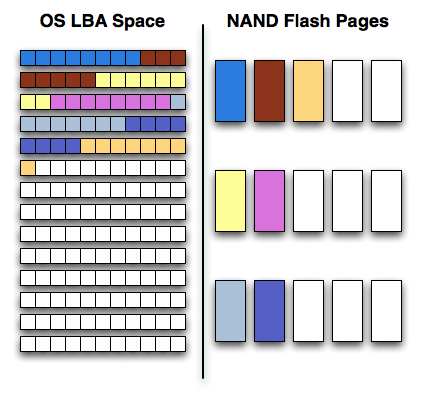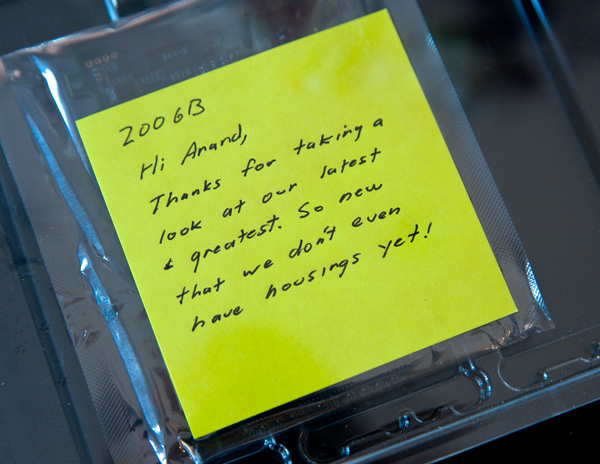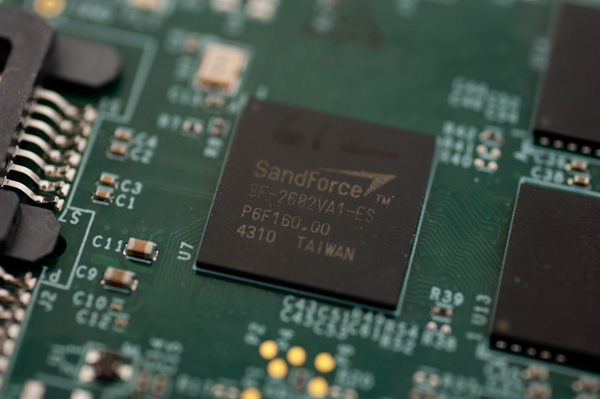OCZ Vertex 3 Pro Preview: The First SF-2500 SSD
by Anand Lal Shimpi on February 17, 2011 3:01 AM ESTFor the past six months I've been working on research and testing for the next major AnandTech SSD article. I figured I had enough time to line up its release with the first samples of the next-generation of high end SSDs. After all, it seems like everyone was taking longer than expected to bring out their next-generation controllers. I should've known better.
At CES this year we had functional next-generation SSDs based on Marvell and SandForce controllers. The latter was actually performing pretty close to expectations from final hardware. Although I was told that drives wouldn't be shipping until mid-Q2, it was clear that preview hardware was imminent. It was the timing that I couldn't predict.
A week ago, two days before I hopped on a flight to Barcelona for MWC, a package arrived at my door. OCZ had sent me a preproduction version of their first SF-2500 based SSD: the Vertex 3 Pro. The sample was so early that it didn't even have a housing, all I got was a PCB and a note:
Two days isn't a lot of time to test an SSD. It's enough to get a good idea of overall performance, but not enough to find bugs and truly investigate behavior. Thankfully the final release of the drive is still at least 1 - 2 months away, so this article can serve as a preview.

The Architecture
I've covered how NAND Flash works numerous times in the past, but I'll boil it all down to a few essentials.
NAND Flash is non-volatile memory, you can write to it and it'll store a charge even if you remove power from the device. Erase the NAND too many times and it will stop being able to hold a charge. There are two types of NAND that we deal with: single-level cell (SLC) and multi-level cell (MLC). Both are physically the same, you just store more data in the latter which drives costs, performance and reliability down. Two-bit MLC is what's currently used in consumer SSDs, the 3-bit stuff you've seen announced is only suitable for USB sticks, SD cards and other similar media.

Writes to NAND happen at the page level (4KB or 8KB depending on the type of NAND), however you can't erase a single page. You can only erase groups of pages at a time in a structure called a block (usually 128 or 256 pages). Each cell in NAND can only be erased a finite number of times so you want to avoid erasing as much as possible. The way you get around this is by keeping data in NAND as long as possible until you absolutely have to erase it to make room for new data. SSD controllers have to balance the need to optimize performance with the need to write evenly to all NAND pages. Conventional controllers do this by keeping very large tables that track all data being written to the drive and optimizes writes for performance and reliability. The controller will group small random writes together and attempt to turn them into large sequential writes that are easier to burst across all of the NAND devices. Smart controllers will even attempt to reorganize data while writing in order to keep performance high for future writes. All of this requires the controller to keep track of lots of data, which in turn requires the use of large caches and DRAMs to make accessing that data quick. All of this work is done to ensure that the controller only writes data it absolutely needs to write.

SandForce's approach has the same end goal, but takes a very different path to get there. Rather than trying to figure out what to do with the influx of data, SandForce's approach simply writes less data to the NAND. Using realtime compression and data deduplication techniques, SandForce's controllers attempt to reduce the size of what the host is writing to the drive. The host still thinks all of its data is being written to the drive, but once the writes hit the controller, the controller attempts to reduce the data as much as possible.

The compression/deduplication is done in realtime and what results is potentially awesome performance. Writing less data is certainly faster than writing everything. Similar technologies are employed by enterprise SAN solutions, but SandForce's algorithms are easily applicable to the consumer world. With the exception of large, highly compressed multimedia files (think videos, MP3s) most of what you write to your HDD/SSD is pretty easily compressible.
You don't get any extra space with SandForce's approach, the drive still has to accommodate the same number of LBAs as it advertises to the OS. After all, you could write purely random data to the drive, in which case it'd behave like a normal SSD without any of its superpowers.
Since the drive isn't storing your data bit for bit but rather storing hashes, it's easier for SandForce to do things like encrypt all of the writes to the NAND (which it does by default). By writing less, SandForce also avoids having to use a large external DRAM - its designs don't have any DRAM cache. SandForce also claims to be able to use its write-less approach in order to use less reliable NAND, in order to ensure reliability the controller actually writes some amount of redundant data. Data is written across multiple NAND die in parallel along with additional parity data. The parity data occupies the space of a single NAND die. As a result, SandForce drives set aside more spare area than conventional controllers.
What's New
Everything I've described up to this point applies to both the previous generation (SF-1200/1500) and the new generation (SF-2200/2500) of SandForce controllers. Now let's go over what's new:
1) Toggle Mode & ONFI 2 NAND support. Higher bandwidth NAND interfaces mean we should see much better performance without any architectural changes.
2) To accommodate the higher bandwidth NAND SandForce increased the size of on-chip memories and buffers as well as doubled the number of NAND die that can be active at one time. Finally there's native 6Gbps support to remove any interface bottlenecks. Both 1 & 2 will manifest as much higher read/write speed.
3) Better encryption. This is more of an enterprise feature but the SF-2000 controllers support AES-256 encryption across the drive (and double encryption to support different encryption keys for separate address ranges on the drive).
4) Better ECC. NAND densities and defect rates are going up, program/erase cycles are going down. The SF-2000 as a result has an improved ECC engine.

All of the other features that were present in the SF-1200/1500 are present in the SF-2000 series.












144 Comments
View All Comments
jwilliams4200 - Friday, February 18, 2011 - link
In that case, it would be helpful to print two after-TRIM benchmarks: (1) immediately after TRIM and (2) steady-state after-TRIM (i.e., TRIM, let the drive sit idle for long enough for GC to complete, then benchmark again)jcompagner - Thursday, February 17, 2011 - link
what i never understood or maybe i should read a bit more the previous articles, is that how come that a SSD can write many times faster then it can read?It seems to me that read is way easier to do then write...
vol7ron - Friday, February 18, 2011 - link
I originally thought that, but SSDs first write to the controller, which organizes the data for storing it to the disk. The major point is that the data can go anywhere in the array of NAND nodes and the list of the next available node in the stack is available almost immediately, whereas a read requires a hash lookup of where the data is stored, which means the seek could take longer to accomplish.I, as well, am not certain that's true, but that's my best guess.
AnnihilatorX - Saturday, February 19, 2011 - link
Only for Sandforce controllers.Sandforce compresses the incoming data at real time. If the incoming data is highly compressible, in a very extreme example, writting a 500MB blank text file, will be instantaneous. So you see 500MB/ms or something ridiculous.
It is also possible for write speeds to exceed read in burst when small amount of data is written to DRAM on other controllers
Soul_Master - Thursday, February 17, 2011 - link
For zero impact from source performance, I suggest to copy data from RAM drive to your test hard disk.Anand Lal Shimpi - Thursday, February 17, 2011 - link
That's a great suggestion. I ran out of time before I left the country but I'll be playing with it some more upon my return :)Take care,
Anand
MrBrownSound - Thursday, February 17, 2011 - link
I think the intel x25m was a pretty good control group to send the data from. I would auctally like to see the changes when sending the data through the RAM; that would be interesting.Hacp - Thursday, February 17, 2011 - link
Anand,You still direct your readers to your Vertex2 article but OCZ has changed its performance on those drives. Your results are no longer valid and it would be dishonest to link the old Vertex2 performance numbers in this new article when they do not reflect the new slower performance of the Vertex2 today.
Anand Lal Shimpi - Thursday, February 17, 2011 - link
I've seen the discussion and based on what I've seen it sounds like very poor decision making on OCZ's behalf. Unfortunately my 25nm drive didn't arrive before I left for MWC. I hope to have it by the time I get back next week and I'll run through the gamut of tests, updating as necessary. I also plan on speaking with OCZ about this. Let me get back to the office and I'll begin working on it :)As far as old Vertex 2 numbers go, I didn't actually use a Vertex 2 here (I don't believe any older numbers snuck in here). The Corsair Force F120 is the SF-1200 representative of choice in this test.
Take care,
Anand
Quindor - Thursday, February 17, 2011 - link
Good to hear that you are addressing the problems surrounding the Vertex 2 drives. There aren't many websites out there which deliver well thought through reviews and bechmarks such as Anandtech does, although some are getting better.I did some benchmarks on my own and with the new 25nm NAND the new 180GB OCZ Vertex2 can actually be slower then my more then a year old 120GB OCZ Vertex1.
If anyone is interested. They can find an overview of the benchmarks performed on the following page. https://picasaweb.google.com/quindor/Benchmarks#
Still, I would love to see an in depth comparsion as you are famous for. ;)
For my personal usage scenario (my own ESXi server), the speed decrease will be of minimal effect because running multiple template cloned guests, the dedup and compression should be able to do their work just fine. ;)